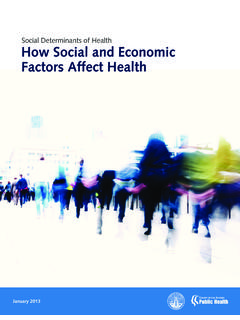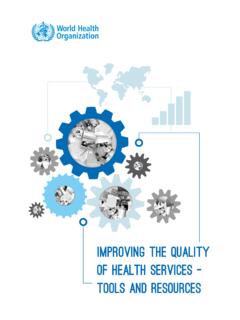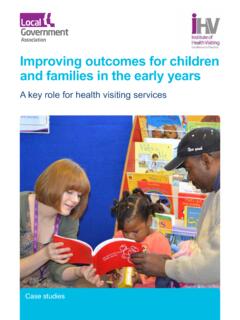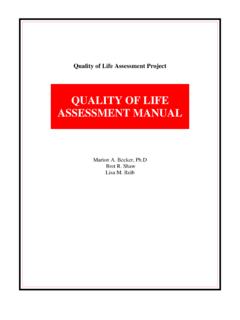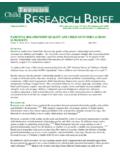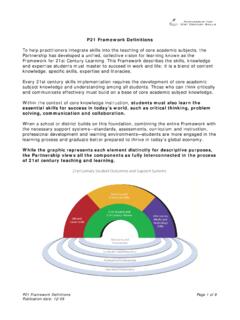Transcription of Measuring Healthy Days
1 Measuring Healthy Days Population Assessment of health -Related quality of life DEPARTMENT OF health AND HUMAN SERVICES Centers for Disease Control and Prevention National Center for Chronic Disease Prevention and health Promotion Division of Adult and Community health November 2000 Measuring Healthy Days Population Assessment of health -Related quality of life DEPARTMENT OF health AND HUMAN SERVICES Centers for Disease Control and Prevention National Center for Chronic Disease Prevention and health Promotion Division of Adult and Community health Atlanta, Georgia November 2000 Suggested citation: Centers for Disease Control and Prevention.
2 Measuring Healthy Days. Atlanta, Georgia: CDC, November 2000. For additional information: For general information about the Healthy Days measures, contact: health Care and Aging Studies Branch, Mailstop K-45, DACH, NCCDPHP, CDC, 4770 Buford Highway NE, Atlanta, Georgia 30341 (Tel: 770-488-5464). For information about public-domain Behavioral Risk Factor Surveillance System (BRFSS) methods or data, see: or contact your State BRFSS Coordinator (contact information available on this website). Acknowledgments: Virginia Ross Taylor (writer-editor), Kerstin Weis (manuscript design), Behavioral Risk Factor Surveillance System State Coordinators, CDC health Care and Aging Studies Branch staff, reviewers of the draft manuscript who provided comments and corrections, and developers, researchers, and users of the Healthy Days measures, who provided the expert guidance and technical material on which this report was based.
3 The cover design has been adapted from the Mona Lisa by Leonardo da Vinci, which is in the permanent collection of the Musee du Louvre in Paris, France. Measuring Healthy Days 1 Measuring Healthy Days EXECUTIVE SUMMARY ..4 INTRODUCTION ..5 Why quality of life ? ..5 What is quality of life ? ..5 What is health -related quality of life ? ..6 Why is it important to track HRQOL? ..6 How can HRQOL be measured? ..7 Healthy DAYS METHODS ..8 How is the summary index of unhealthy days calculated? ..8 Why collect data about health perceptions? ..9 What is the BRFSS? ..10 What is the advantage of having core HRQOL questions on the BRFSS?
4 10 Why ask How many days .. when other questions like rating your overall health are easier to answer? ..10 How can you measure HRQOL with only four questions? .10 Why are most of the measures oriented toward the negative side of health ? ..11 How do the Healthy Days measures differ from QALYs, DALYs, and YHLs? ..12 FINDINGS ..12 What have been some of the findings from the Healthy Days core questions? (nationwide, state comparisons, seasonal patterns, and time trends) ..12 VALIDATION ..15 Do these questions accurately measure HRQOL? ..15 What challenges in measurement have been identified?
5 18 What is being done to address problems in accuracy? ..19 PRACTICAL APPLICATIONS ..20 What are some of the cross-cultural uses of the Healthy Days measures? ..20 How are the Healthy Days measures useful at the state and local levels? ..20 How are the HRQOL measures being used to identify and address the needs of special populations? ..21 2 Measuring Healthy Days POLICY IMPLICATIONS ..26 What are the policy implications of HRQOL surveillance? ..26 Why is HRQOL surveillance important in Healthy People 2010? ..26 How do Healthy Days relate to the Healthy People 2010 Leading health Indicators?
6 26 How can the Healthy Days measures support epidemiologic and prevention research? ..28 How can an HRQOL focus support community mobilization? ..28 CONCLUSIONS AND FUTURE DIRECTIONS ..29 What are the main advantages of the Healthy Days measures and population data? ..29 What areas need future study and analysis? ..30 Conclusion ..30 REFERENCES ..31 RESOURCES ..33 TABLES ..34 Table 1..34 Self-rated health , unhealthy days, and activity limitation days, adjusted for age Behavioral Risk Factor Surveillance System, 1993 1997, by: A. demographic group B. health condition C. behavioral risk factor D.
7 Self-rated health Table 2..37 health -related quality -of- life measures for states using the optional quality of life Module Behavioral Risk Factor Surveillance System, 1995 1997 by: A. state and year B. demographic group C. health condition D. behavioral risk factor E. self-rated health F. extent of activity limitation G. main cause of activity limitation Use of trade names and commercial sources is for identification only and does not imply endorsement by the Department of health and Human Services. References to non-CDC sites on the Internet are provided as a service and do not con stitute or imply endorsement of these organizations or their programs by CDC or the Department of health and Human Services.
8 CDC is not responsible for the content of pages found at these sites. Measuring Healthy Days 3 Measuring Healthy Days Executive Summary EXECUTIVE SUMMARY World health Organization s defi nition of health . The demonstrated value of these measures and the This technical report, Measuring Healthy Days, describes the origins, validi-ty, and value of a set of survey meas ures developed by the Centers for Disease Control and Prevention (CDC) and its partners for use in tracking population health status and health -related quality of life (HRQOL) in states and communi ties.
9 The first four of these measures pertain to general self-rated health and recent days of physical health , mental health , and activity limitation. These measures have been part of the full sample Behavioral Risk Factor Surveillance System (BRFSS) core since 1993 and were added, beginning in 2000, to the examination compo continuous accumulation of public domain data have resulted in sup port from the CDC Disability, Women s health , and Arthritis Programs. The HRQOL measures and data have also been used for research or program planning by health is a state of complete physical, mental, and social well-being not merely the absence of disease, or infirmity.
10 -World health Organization, 1948 nent of the National health and Nutrition Examination Survey (NHANES). An additional five measures of activity limitation and five questions on recent days of pain, depression, anxiety, sleeplessness, and vitality con stitute an optional quality -of- life module added to the BRFSS in 1995. The primary target audiences for this report are pub lic health professionals with a current stake or potential interest in HRQOL measurement. The report identifies the policy origins of the Healthy Days measures, dis cusses how HRQOL differs from other health and social constructs, and summarizes several studies designed to test the reliability, validity, and responsiveness of the measures.










